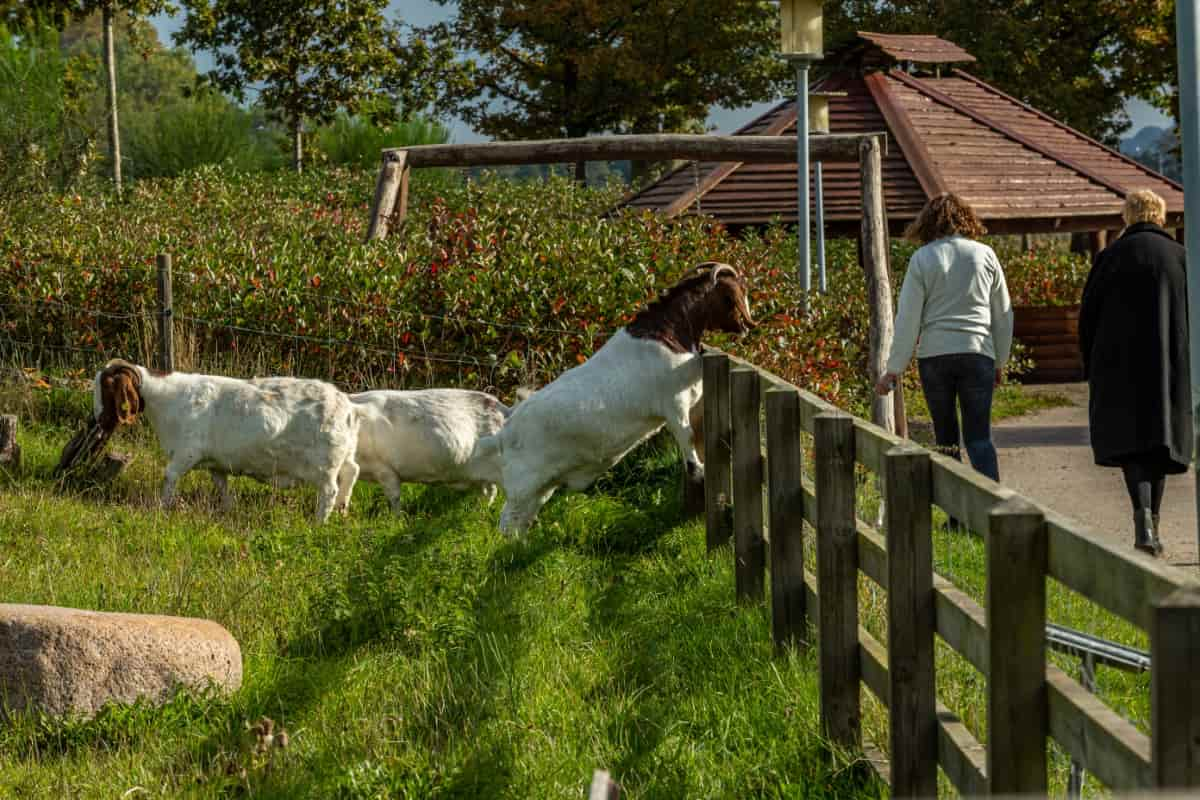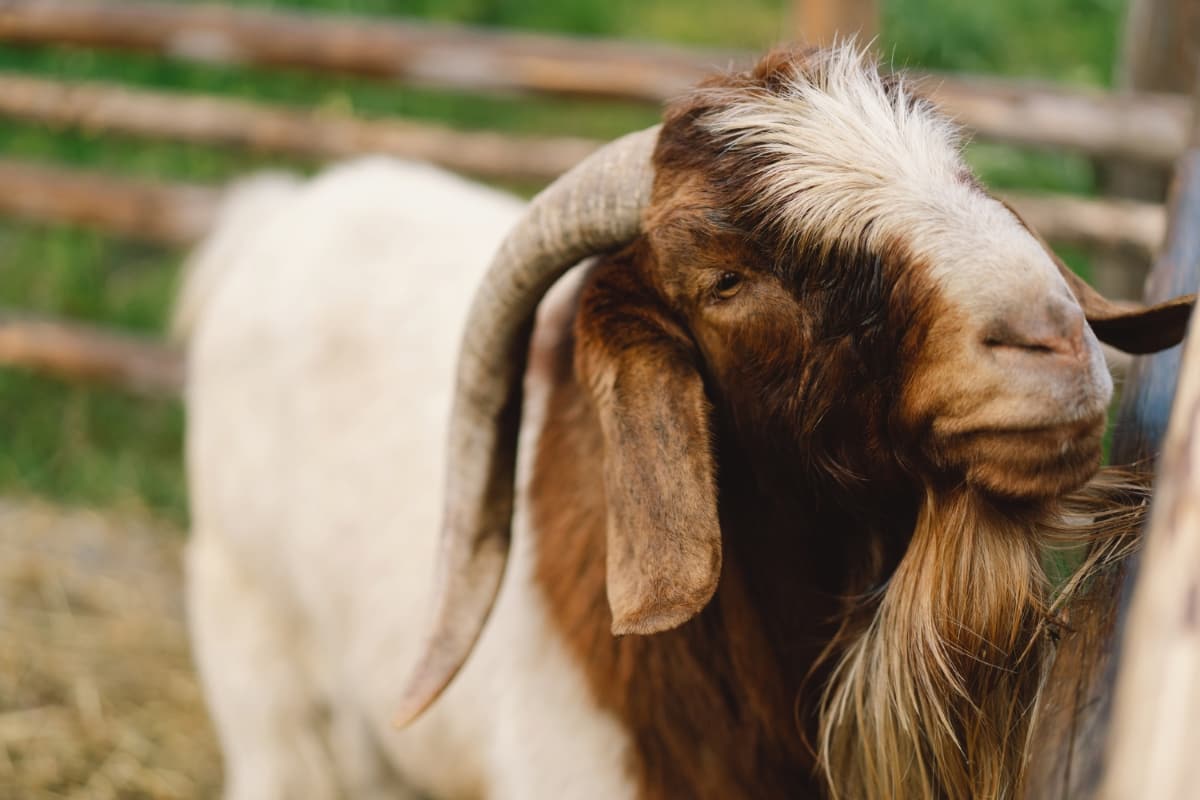Originating from South Africa, the Boer goat breed has a rich history that dates back centuries. Bred specifically for meat production, these goats are renowned for their exceptional growth rate and high fertility. The name “Boer” is derived from the Dutch word for farmer, reflecting the breed’s popularity among farmers in the region. Boer goats were developed in the early 1900s through selective breeding, focusing on hardiness, adaptability, and superior meat quality traits.

Today, Boer goats are widely recognized for their robust nature and are valued for their superior meat production capabilities. They have gained significant popularity worldwide, including in the United States, where they are highly sought after for their excellent meat yield and adaptability to various climates.
Understanding the Distinctive Traits of the Boer Goat Breed
- Its body is usually white, while its head and neck are usually reddish brown.
- Some appear almost completely brown, white, or painted. There are varying colors of spots on the bodies of painted variants.
- A male can be differentiated from a female by his larger size and characteristically long neck hair.
- The horns of both males and females curve backward, with male horns typically measuring longer and thicker at the base.
- Additionally, these goats have long, downward-hanging ears.
Price Range of Boer Goats: Factors Affecting the Cost of Boer Goats
The price range of Boer goats varies depending on several factors. One of the key factors affecting the cost is the goat’s age. Typically, younger goats are less expensive than older ones. Another factor is the gender of the goat. Bucks (males) tend to be more expensive than does (females) due to their breeding potential.
Additionally, the quality and pedigree of the goat are significant in deciding the price. Purebred Boer goats with desirable traits and bloodlines often command higher prices. Furthermore, the location and demand in the market influence the cost. In areas where Boer goats are in high demand, prices may be higher. Overall, the price range for Boer goats can vary greatly, ranging from 150-250 USD, depending on these factors.
Size and Weight of Boer Goats
- Boer goats are the largest goat breed in the world. Females can weigh up to 120 kg as adults, but most weigh around 95 kg.
- While adult males can weigh up to 175 kg or more, the average weight is around 120 kg.
- Both females and males are about 30 inches tall at the shoulder, although some specimens can reach 44 inches.
Boer Goat Life Span
The Boer goat, a popular breed known for its meat production, has an average lifespan of 10 to 15 years. These goats are hardy and adaptable, making them suitable for various climates. With proper care and nutrition, Boer goats can live a long and productive life on farms and ranches.
Boer Goat Pros and Cons
Pros of Raising Boer Goats: Benefits and Advantages
- Boer goats are highly sought after for their meat, making them a profitable investment for farmers and ranchers.
- These goats are known for their hardiness and adaptability, requiring less maintenance than other livestock.
- Boer goats have a high fertility rate, allowing for increased breeding potential and larger herd size.
- Boer goats exhibit rapid growth, reaching market weight at an early age. This reduces feeding costs and increases profit potential.
- Boer goats are excellent foragers, utilizing a wide range of vegetation, which can reduce feed costs.
- Their calm and docile nature makes Boer goats easy to handle, making them the best choice for beginners or those with limited experience.
In case you missed it: 10 Common Mistakes to Avoid in Goat Farming for Healthy Profits

Cons of Raising Boer Goats: Challenges and Considerations to Keep in Mind
- Raising Boer goats requires a significant initial investment in purchasing the goats, constructing suitable housing, and providing necessary equipment and supplies.
- Caring for Boer goats requires a considerable amount of time and effort. They need daily feeding, watering, and monitoring for signs of illness or distress.
- Boer goats require ample grazing space to meet their dietary needs. This can be a challenge if you have limited land or the available pasture is insufficient.
- Boer goats are known for their agility and curiosity, making them prone to escaping. Secure fencing is essential to prevent them from wandering off or getting into trouble.
- Boer goats are susceptible to various health issues, including parasites, respiratory diseases, and foot problems. Regular veterinary care and preventive measures are necessary to maintain their well-being.
Boer Goat Breeding Programs: Prominent Initiatives for Improving the Breed
Boer goat breeding programs are crucial for improving the breed’s quality and productivity. Several prominent initiatives have been implemented to achieve this goal. One such initiative is the selection of superior breeding stock based on desired traits like fast growth, high fertility, and good meat quality. Additionally, controlled mating and artificial insemination techniques ensure genetic diversity and improve breed characteristics.
Another important aspect of breeding programs is the implementation of health and nutrition management practices to ensure the overall well-being of the goats. Furthermore, research and development efforts are ongoing to enhance the breed through advanced breeding techniques and genetic technologies.
Boer Goat Meat Quality: Exploring the Culinary Aspects of Boer Goat Meat
Boer Goat meat is known for its exceptional quality, making it a sought-after choice among culinary enthusiasts. The meat is renowned for its tender texture and distinct flavor, making it a versatile ingredient in various dishes.
The succulent and juicy nature of Boer Goat meat lends itself well to grilling, roasting, and braising, allowing for a wide range of culinary creations. Its rich and savory taste pairs well with a variety of seasonings and spices, enhancing the overall dining experience. Boer Goat meat’s quality lies in its ability to deliver a mouthwatering and memorable meal, making it a top choice for discerning palates.
Boer Goat Market Demand: Analyzing the Growing Popularity and Economic Significance
Boer goat market demand has been steadily increasing due to its growing popularity and economic significance. The Boer goat breed, originally from South Africa, has gained recognition for its robustness, adaptability, and high-quality meat production. Its lean and flavorful meat has made it a preferred choice for consumers, leading to a surge in demand.
In case you missed it: Toggenburg Goat Breed: Origin, Characteristics, Size, Milk Production, Price, Pros, and Cons

Additionally, the Boer goat industry has become economically significant as it provides opportunities for farmers to diversify their livestock operations and generate additional income. The rising demand for Boer goats has created a thriving market, attracting both small-scale and commercial breeders. This trend highlights the promising future of the Boer goat market and its potential for continued growth.
Conclusion
In addition to keeping the land free of bushes and other woody vegetation, Boer goats make great pets. Additionally, it produces high-quality meat. I hope you have enjoyed learning more about this popular goat breed and found the answers you were looking for.
- Feed Your Flock for Less: Top 10 Tips to Save on Chicken Feed
- Ultimate Guide to Ossabaw Island Hog: Breeding, Raising, Diet, and Care
- Hatching Answers: The Top 10 Reasons Your Chickens Aren’t Laying Eggs
- Eggs and Economics: Breaking Down the Cost of Raising Backyard Chickens
- Defend Your Greens: Proven Methods to Keep Iguanas Out of Your Garden
- Ultimate Guide to Cinnamon Queen Chicken: A Comprehensive Guide for Beginners
- Ultimate Guide to California Tan Chicken: Breeding, Raising, Diet, Egg-Production and Care
- Ultimate Guide to Marsh Daisy Chicken: Breeding, Raising, Diet, and Care
- 10 Types of Chicken Farming Businesses You Can Start for Profits